
Antiscopa is a genus of moths of the family Crambidae. It was first described by Eugene Munroe in 1964. This genus is endemic to New Zealand. The type species of this genus is Antiscopa epicomia.

Gadira is a genus of moths of the family Crambidae. This genus is endemic to New Zealand.
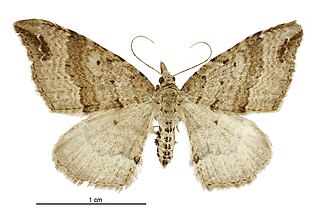
Homodotis is a genus of moths in the family Geometridae erected by Edward Meyrick in 1885. All the species in this genus are endemic to New Zealand.

Heterocrossa adreptella is a moth of the Carposinidae family. This species was long considered the New Zealand raspberry budmoth however this was a taxonomic misinterpretation of the type material used to describe this species. This error was corrected in 1988 with the New Zealand raspberry budmoth giving its own species name Heterocrossa rubophaga. H. adreptella is endemic to New Zealand and has been collected in the Wellington Botanic Garden and been observed resting on mānuka branches.
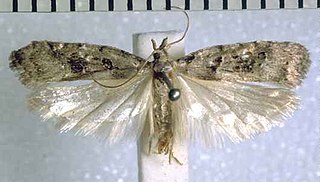
Heterocrossa canescens is a species of moth in the family Carposinidae. It is endemic to New Zealand. This species has been observed in Aoraki / Mount Cook National Park and in the Southern Alps. The larvae of this species feed on the fruits and flowers of endemic to New Zealand species in the genus Gaultheria. Adult moths are on the wing in November and from January to March.
Heterocrossa ignobilis is a species of moth in the family Carposinidae, endemic to New Zealand.

Heterocrossa contactella is a species of moth in the family Carposinidae. It is endemic to New Zealand and can be observed in both the North and South Islands. The preferred habitat of this species is native forest and scrub, especially where Leptospermum shrubs are found. Adults are on the wing in December and January.
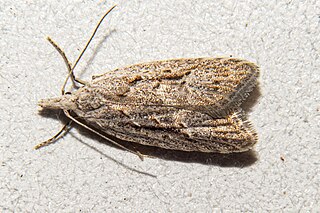
Heterocrossa cryodana is a species of moth in the family Carposinidae. It is endemic to New Zealand and is found in the southern parts of the South Island as well as at Codfish Island / Whenua Hou. This moth is associated with plants in the Leptospermum genus. Adults are on the wing from September until January.

Heterocrossa epomiana is a species moth in the family Carposinidae. It is endemic to New Zealand and has been observed in Westland. Adults are on the wing in January. This species is visually very similar to H. gonosemana and to H. philpotti.

Heterocrossa eriphylla, also known as the lichen snoutlet moth, is a species of moth in the family Carposinidae. It is endemic to New Zealand and is found in the North Island and the northern parts of the South Island. This species is regarded as relatively uncommon and inhabits native forest. The larvae feed on the healing wounds of New Zealand beech trees Fuscospora fusca and Fuscospora truncata. It pupates at its feeding site and emerges from December onward. The adult moth is nocturnal and is attracted to light. During the day the moth rests on lichen covered tree trunks where their lichen mimicking colouration assists with their camouflage.

Heterocrossa exochana is a species of moth in the family Carposinidae. It is endemic to New Zealand and has been observed in the North and South Islands. The larvae of this species feed on the fruits of Muehlenbeckia species. The adult is on the wing from September until May and are attracted to light.

Heterocrossa gonosemana is a species of moth in the family Carposinidae. It is endemic to New Zealand and is found throughout the country. It inhabits native forest. Larvae feed on seeds and fruit of Griselinia lucida and possibly Griselinia littoralis. They can be extremely active when disturbed. This species overwinters as a pupa, enclosed in a cocoon, underneath its host plant. Adults are on the wing from November until February and can be found during the day resting on lichen covered tree trunks where they are well camouflaged. The adult is nocturnal and is attracted to light.

Heterocrossa iophaea is a species of moth in the family Carposinidae. It is endemic to New Zealand.

Heterocrossa literata is a moth of the Carposinidae family first described by Alfred Philpott in 1930. It is endemic to New Zealand and has been observed the Franz Josef Glacier in subalpine habitat on the West Coast. Adults are on the wing in January.
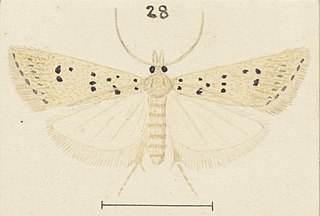
Heterocrossa maculosa is a species of moth in the family Carposinidae. It is endemic to New Zealand. It is classified as "Data Deficient" by the Department of Conservation.
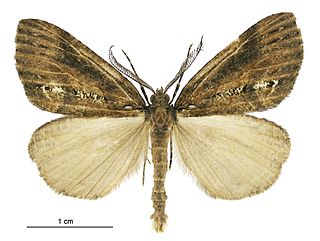
Chalastra ochrea is a moth of the family Geometridae. It is endemic to New Zealand. It has been observed in both the North and South Islands and inhabits native forest. Larvae of C. ochrea feed on the leaves of species in the genus Sophora including Sophora chathamica. Adults are on the wing from February until April. They have been collected via sugar traps.

Glaucocharis auriscriptella, also known as the yellow silverling, is a moth in the family Crambidae. It was first described by Francis Walker in 1864 and is endemic to New Zealand. This species can be found in the North, South, Stewart and Great Barrier Islands. The preferred habitat of this moth is lowland and subalpine native forest as well as wetlands. The larvae feed on moss. The adult moth is day flying and is on the wing from November to February. It can be observed in colonies and can be attracted to light at night. This species likely has only one generation per year.
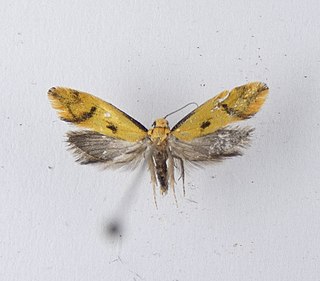
Tingena actinias is a species of moth in the family Oecophoridae. It is endemic to New Zealand and is found on the North and South Islands. The larvae of this species are leaf litter feeders. The preferred habitat of this species is shrubland and it has also been observed in gumland heaths and in beech forest.

Reductoderces is a genus of moths of the Psychidae family. This genus is endemic to New Zealand and the type species is Reductoderces fuscoflava.


















